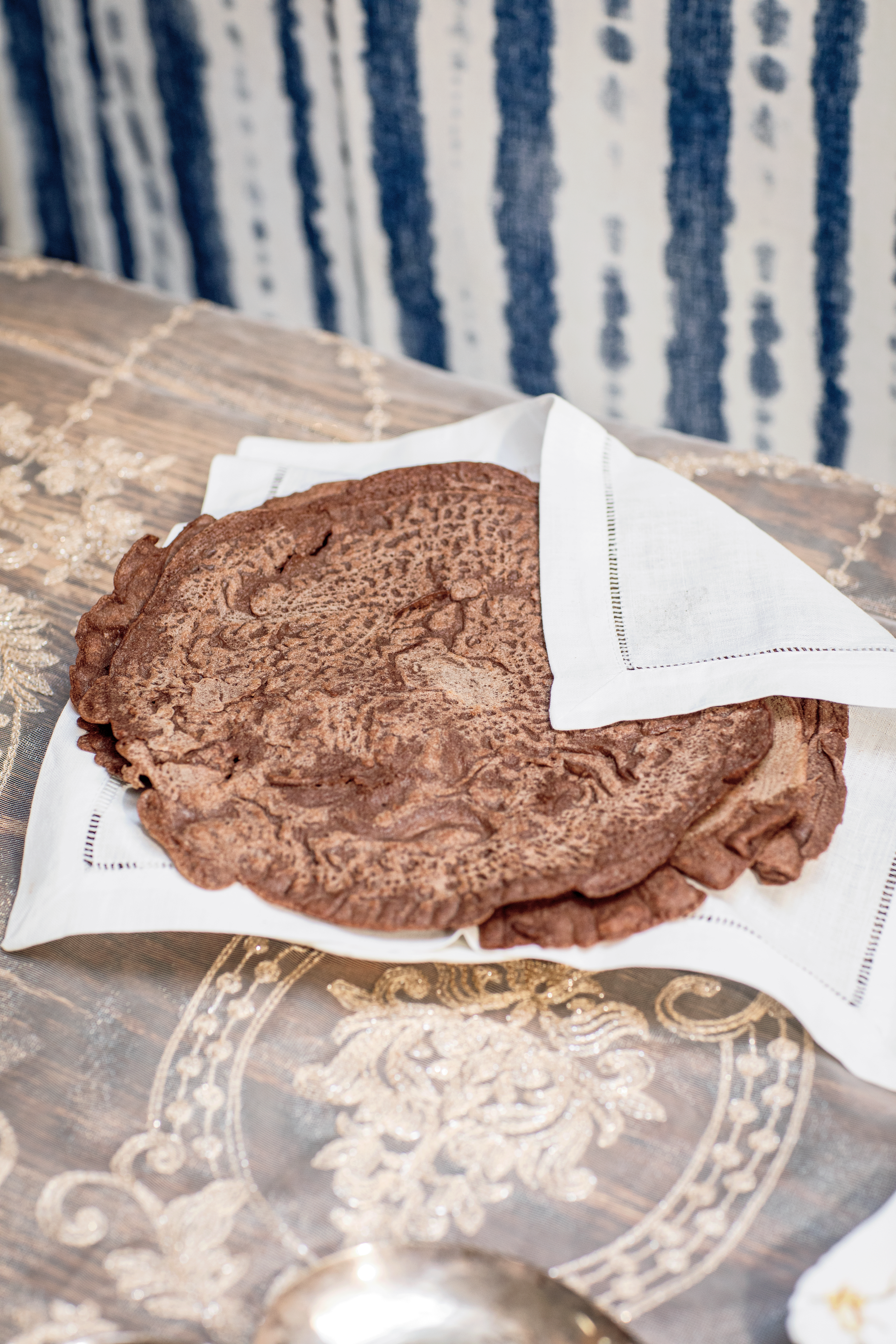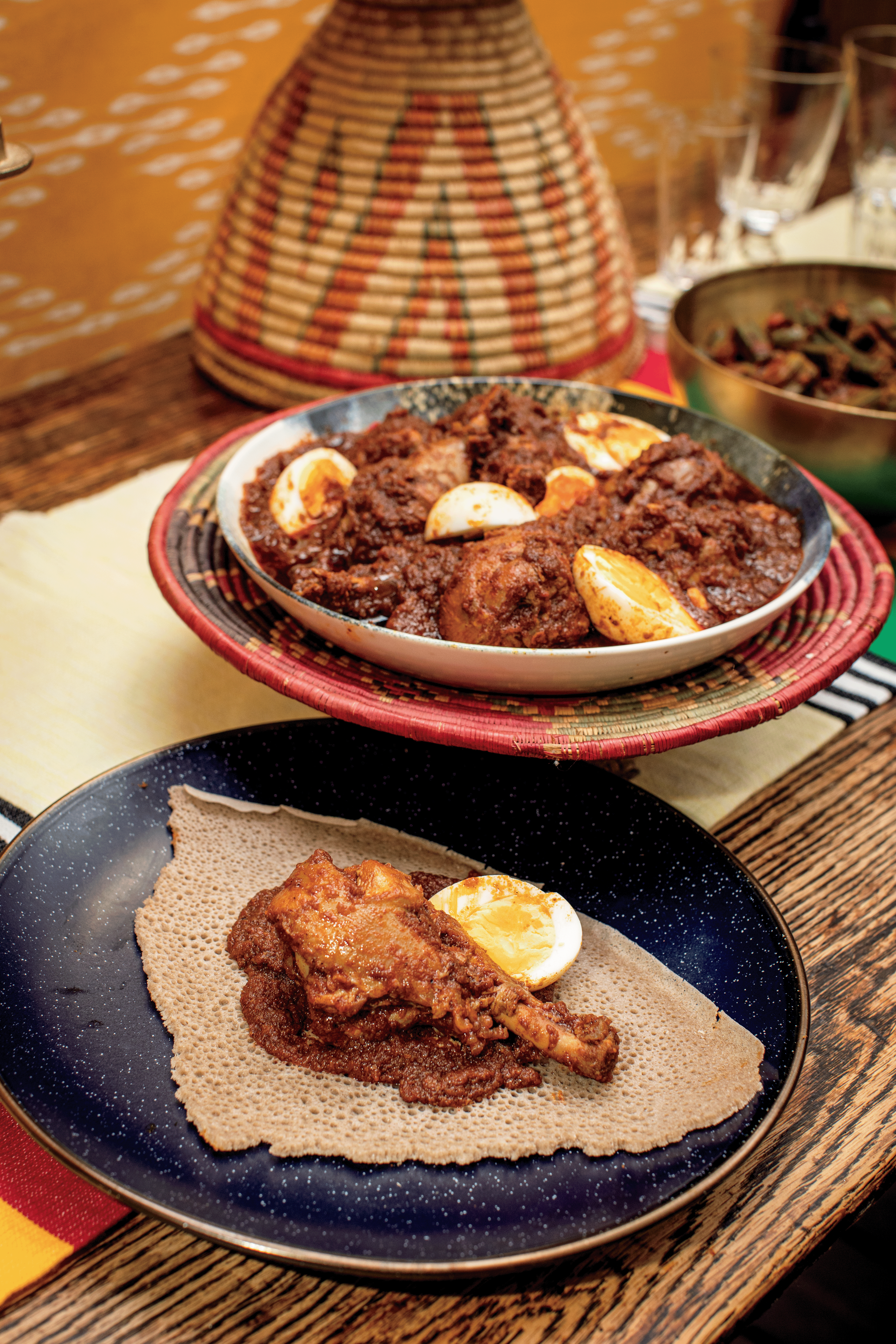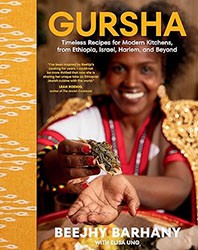
Author photo by Clay Williams
Ya Fassikah Kita/Nay Wurenah Kicha
Ethiopian Matzah
Feel free to use just one type of teff flour in this special Ethiopian matzah that is suitable for Passover because it does not rise, leaven, or ferment. My grandmother made it every morning during Passover, mixing the batter right after she woke up and serving the matzah for breakfast. My family adhered so strictly to Jewish law that they ate it plain or with flaxseed: less stringent eaters may enjoy it with Niter Kibbeh.
Makes 3 to 4 large matzahs
½ cup (115 grams) ivory teff flour
½ cup (115 grams) brown teff flour
1 teaspoon fine sea salt
2 cups (480 grams) lukewarm water
1 tablespoon vegetable oil (omit if using a nonstick pan)
In a large bowl, use your hands to combine the teff flours, salt, and lukewarm water, breaking up clumps of flour, until smooth.
Warm a 12-inch skillet over high heat. If the skillet does not have a nonstick coating, add the oil and swirl to coat the pan.
Pour 1 cup batter into the center of the pan and use the bottom of a ladle to spread it over the surface of the pan. Cook until dry on top, about 3 minutes. Push a wide spatula underneath the matzah, and carefully flip it over. Reduce the heat to medium-low and cook until the matzah is completely cooked through, about 3 minutes. Repeat with the remaining batter. Serve immediately.

Photo by Clay Williams
Doro Wot / Derho Tsebhi
Spicy Chicken Drumstick Stew
Doro wot is perhaps the most well- known Ethiopian dish: The mere presence of this rich, fiery chicken stew signifies a rite of passage or a special occasion. Cutting up a whole chicken for doro wot is among the first skills that Ethiopian Jewish mothers teach their daughters. And at meals, each family member is allocated a specific piece of meat based on their status in the household: honored guests might get the thigh or breast, children the wings. At Ethiopian weddings, the bride and groom are fed by their close friends, a way of showing love, respect, and friendship known as Gursha. While making a truly finger-licking doro wot is a lengthy process, I have carefully streamlined my version over the years to maximize the flavor. (Note: Beejhy includes two other variations of this recipe in the cookbook.)
Serves about 8
2 pounds chicken drumsticks (8 – 10), skinned
2 tablespoons fresh lemon juice
1 tablespoon fine sea salt
8 large eggs
6 cups Kulet (recipe follows)
In a large bowl, combine the drumsticks, lemon juice, and salt. Add cold water to cover and swish the water around to mix. Soak for at least 10 minutes and up to 1 hour.
Prepare a large bowl of cold water and ice and have nearby. In a medium pot, combine the eggs with cold water to cover. Bring to a boil over medium heat and cook the eggs for 8 minutes. Remove the eggs from the pot and place in the ice bath until completely cooled.
Peel the eggs, leaving them whole. Make four shallow, evenly spaced cuts from top to bottom on each egg, scoring the white but stopping at the yolk.
Meanwhile, in a large pot, heat the kulet over medium heat, stirring occasionally, until simmering.
Drain the water from the drumsticks. Wash the drumsticks well under running water, massaging the chicken and rinsing several times. Submerge in the kulet. Bring back to a simmer and cook gently, stirring occasionally and reducing the heat if the sauce begins to boil, until the drumsticks are completely cooked through, 25 to 30 minutes. During the last 5 minutes of cooking, add the eggs and gently stir to completely submerge them in the sauce. Serve warm.
Kulet / Silsi
Fragrant Ethiopian Stew Base
The foundation of all thick, spicy Ethiopian stews starts with slow-cooking onions, garlic, ginger, and berbere until they melt into one another. Let this crimson-colored base bubble for a few hours, and you can have dinner all week. Use it to make chicken stew, fish stew, red lentil stew, or all of them at once. Feel free to halve or double the recipe, too. Ethiopian cooks typically chop the onions finely by hand. I make good use of the food processor to shorten this task, with the same luscious results.
Makes about 16 cups
10 – 12 large yellow onions, peeled and quartered
6 cups vegetable oil, plus more if necessary
2 cups Berbere (recipe follows)
4 teaspoons minced garlic
2 teaspoons minced fresh ginger
3 tablespoons fine sea salt
8 cups hot water
6 ounces tomato paste (or 12 ounces, if you prefer less heat)
1 tablespoon Ground Roasted Korarima (recipe follows) or ground cardamom
In a food processor, puree the onions until smooth.
Pour the onions into a large pot and bring to simmer over high heat. Cook, stirring occasionally and reducing the heat if the onions begin browning, until most of the water has evaporated, 35 to 40 minutes.
Stir in the oil and simmer for about 5 minutes to incorporate. Stir in the berbere, garlic, ginger, and salt. The mixture should be moist; if it appears dry, add more hot water, about ½ cup at a time. Cover the pot and cook over medium heat until the onions have taken on a red hue, for another 10 to 15 minutes.
Add the hot water and tomato paste and stir well. Bring to a simmer, then reduce the heat and cook uncovered, stirring occasionally, until the flavors blend and the stew base becomes fragrant, about 1 hour.
Remove from the heat and stir in the korarima. Let cool.
Storage: store in an airtight container in the refrigerator for up to 2 weeks, or in the freezer for up to 3 months.
Berbere
Aromatic Ethiopian Spice Blend
This flavorful, aromatic seasoning blend says a lot about the cook who mixes it. I regard this spice mixture less as a formula and more as a way to express myself. I start mine with plenty of dried chili pepper, as is traditional, but then I add a healthy dose of korarima, because I love the nutty, herbal notes it adds. My mother’s berbere was heavy on serrano pepper, basil, and tiny nigella seeds, infusing her cooking with a signature spicy bite. While I welcome the growing number of grocery stores that carry berbere in the spice section, I find that many of them overdo it on the paprika and cumin, giving food a much flatter taste. Feel free to use my recipe as a starting point for yours, adding more of any flavors you want to emphasize, while decreasing or omitting any you may dislike.
Makes about 2½ cups
1 cup paprika
½ cup cayenne pepper
3 tablespoons Ground Roasted Korarima (recipe follows) or ground cardamom
2 tablespoons ground ginger
1 tablespoon onion powder
1 tablespoon ground coriander
1 tablespoon ground cumin
1 tablespoon black pepper
2 tablespoons fine sea salt
1½ teaspoons ground cloves
1½ teaspoons ground cinnamon
1½ teaspoons ground nutmeg
1½ teaspoons ground fenugreek
In a small bowl, mix all the ingredients together and transfer to an airtight jar.
Storage: store at room temperature for up to 6 months.
Ground Roasted Korarima
Korarima — an Ethiopian spice related to cardamom — is a defining flavor in my food: Its complex, nutty, floral quality perks up so many dishes. When you first purchase korarima, it will most likely come in little seeds that you need to grind into a powder to use in my recipes. Here is how I get the most flavor out of these tiny seeds. You can use as many or as few seeds as you have; vary the pan size accordingly.
Makes about ¼ cup
About ⅓ cup korarima seeds
Warm a medium nonstick pan over medium heat. Add the korarima seeds and roast until shiny and fragrant, 2 to 3 minutes. Transfer to a plate or bowl and let cool completely.
Transfer to a mortar and pestle or spice grinder and grind into a powder. Transfer to an airtight container.
Storage: store at room temperature for up to 3 months.

Photo by Clay Williams
From GURSHA: Timeless Recipes for Modern Kitchens, from Ethiopia, Israel, Harlem, and Beyond © 2025 by Tevletz Barhany-John. Excerpted by permission of Alfred A. Knopf, a division of Penguin Random House LLC. All rights reserved. No part of this excerpt may be reproduced or reprinted without permission in writing from the publisher.
Elisa Ung is an award-winning writer, book collaborator, and editor. She was the restaurant critic and dining columnist for northjersey.com and the Bergen Record in New Jersey, and a staff writer for The Philadelphia Inquirer.



